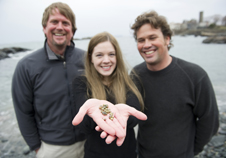Snail travels unknown evolutionary path

Biology graduate student Meredith Doellman and faculty researchers from Northeastern’s Marine Science Center in Nahant, Mass., have discovered that a specific species of snail has a much more complex evolutionary history than previously thought.
Doellman worked with biology professors Geoff Trussell and Steve Vollmer and discovered that a marine periwinkle snail species, Littorina saxatillis, has defied simple textbook classifications of speciation — that is, the formation of new and distinct species in the course of evolution — by combining two types of speciation, an evolutionary strategy not seen before.
Allopatric speciation occurs when two populations become geographically isolated and diverge over time; whereas another, and far less common type, sympatric speciation, occurs in the same geographical location in or around the same stretch of time.
“Our new wide-range understanding of genetic relationships among populations of this snail provides essential context for this important model system in marine evolutionary ecology,” said Doellman, who received a pre-doctoral fellowship from the National Science Foundation to pursue her focus in marine science.
Professor John Grahame from the University of Leeds in the United Kingdom collaborated on the research, which was published earlier this year in the Proceedings of the Royal Society of London, Biological Series.
Researchers compared DNA sequences from samples collected across the North Atlantic, including Iceland, the United States and throughout Europe to infer the evolutionary history of the snail species.
Among the discoveries, researchers found that what was once thought to be one snail species might actually be different snail species inhabiting rocky shorelines on both sides of the North Atlantic. “L. saxatilis definitely needs to be redefined — it is probably two species,” said Trussell. “This also means that within this group there is evidence for multiple, repeated examples of sympatric speciation.”
“The results of this study will surely change how researchers view the creation of new species,” Vollmer said.
The study emerged as part of the National Science Foundation Research Coordination Network, “Coordinating Research on the North Atlantic,” led by biology professor Clifford Cunningham of Duke University.





